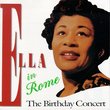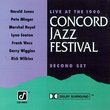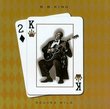| All Artists: Louisville Orchestra Title: Hovhaness: Symphony 15 Members Wishing: 0 Total Copies: 0 Label: First Edition Original Release Date: 1/1/2003 Re-Release Date: 3/11/2003 Album Type: Original recording remastered Genre: Classical Styles: Opera & Classical Vocal, Forms & Genres, Concertos, Historical Periods, Modern, 20th, & 21st Century, Symphonies Number of Discs: 1 SwapaCD Credits: 1 UPCs: 801957000064, 809157000068, 809157000624 |
Search - Louisville Orchestra :: Hovhaness: Symphony 15
CD DetailsSimilarly Requested CDs |
CD ReviewsHeavenly Halvah! Timothy R. O'Hanlon | Hawaii | 02/09/2006 (5 out of 5 stars) "I realize that Hovhaness was of Armenian descent but a lot of his music has a Middle-Eastern flavor, like halvah. Whenever I eat halvah and when I used to drink a strong Lebanese liquor, called Arak, I am often transported to that region. Though all of the works on this CD are worth listening to, I was particularly impressed with Symphony No. 15, Op. 199, subtitled,"Silver Pilgrimage". The movments of this relatively short symphony are: I. Mount Ravana II. Marava Princess III. River of Meditation IV. Heroic Gates of Peace. The Magnificat is also VERY special. Hovhaness' music never fails to transport me to other more exotic worlds and higher dimensions. For me, Hovhaness' music is often like choice halvha sweetened with wild honey!" Interesting music in generally good performances G.D. | Norway | 04/15/2010 (4 out of 5 stars) "In terms of repertoire this is one of the more interesting Hovhaness releases I have encountered. While the music is unmistakably Hovhaness, it is less plush and dreamy than many of his work, grittier and less "Western" in sound. The Concerto no.7 for orchestra was written in 1953, is cast in three movements including a double fugue but apart from that bears little resemblance to his Mysterious Mountain symphony from approximately the same time (presumably his most famous single work). It is a feral work of grinding power and sparkling colors. The second movement also employs a range of unusual percussion instruments and the agitated double fugue is relatively taxing on the listener (not a criticism) with its relentless fervor. This must rank as one of the most impressive Hovhaness works I have heard and it is fortunate that it is so well played as it is here, full of color, exoticism and urgency. The fifteenth symphony, `Silver Pilgrimage' employs elements from Japanesse Gagaku and Indian classical music. The first movement, Mount Ravana is eerie and mysterious with spiteful, irate brass at times punctuating the oppressive atmosphere. The second movement is graceful and light, but with a sense of urgency and panic barely suppressed beneath the quicksilvery surface. The third movement, `River of Meditation' starts out relective and becalmed, evocative of prayer with the repeated flute figures, but soon the river quickens its pace. The final movement `The Heroic Gates of Peace' depicts the triumphal culmination of wisdom and spirit with serenity and power - it is peaceful in virtue of its atmosphere, not its tempos, however, for it strides onwards rather briskly. In any case none of the movements display much traditional symphonic development, relying rather on mood and atmosphere, and while the whole is to a certain extent less than the sum of its parts, it is a work worth hearing, and I have no qualms about the performances by the Louisville Orchestra under Robert Whitney. The Magnificat for soloists, chorus and orchestra is a large-scale work in twelve sections, which according to the composer seeks to recreate the atmosphere of mystery, inspiration and mysticism of early Christianity. It draws heavily on plainsong and chant-like melodies and also employs the composer's free rhythm textures (the chorus moving from plainchant melodies to a swirling, early-Penderecki-like loud fog of sound, then receding to nothingness). Unfortunately the work comes across as more gimmicky than actually effective - there are good ideas here, but it does seem like the composer has too hastily cobbled them together. More than in the symphony, I missed the overall sense of purpose and musical development. The orchestral playing is good, the chorus acceptable and the soloists are, well, often good enough but sometimes barely above the cringe-worthy. The sound quality of the disc, however, is pretty good, even in the early mono recordings. In the end I am not convinced this disc will earn the composer new fans, but I did find much of it very rewarding - especially the concerto." Not essential maybe, but, at its best, individual evidently Discophage | France | 01/10/2008 (4 out of 5 stars) "In the LP era I stayed aloof from the music of Alan Hovhaness, other than "Mysterious Mountain", which I had only because of Reiner's recording with Stravinsky's "Fairy's Kiss" (and that didn't really prompt me to try and listen to more). I had the impression that a man who had composed so many symphonies and orchestral pieces, with such mystic titles, usually conducted by himself and published on esoteric labels which I suspected were composer-funded, and who seemed a maverick loner anyway among contemporary music schools of all sorts, couldn't possibly have written good music. I am happy then that my ongoing survey of the Louisville Orchestra's recorded legacy has given me a chance to get better acquainted with his music. I can't say I find it essential, but, at its best (the two orchestral pieces), individual evidently and pleasurable certainly.
Concerto #7 for Orchestra was recorded as early as 1954 and came out on one of the first LPs released by the orchestra's famed label, First Edition Records 545-4, as part of a first subscription of twelve. It was paired then with Castelnuovo-Tedesco's Overture for "Much Ado about Nothing" and Surinach's Sinfonietta (the latter now on an all-Surinach disc, xx). Magnificat was recorded in 1961 and released on LOU-614 with Chou Wen-Chung's "All In The Spring Wind". The same recording has also been reissued on CD by Crystal, paired with the composer's "Saturn" - a non-Louisville recording (Hovhaness: Magnificat, Op.157/Saturn, Op.243). Finally Symphony # 15 "Silver Pilgrimage", recorded in 1965, came on LS 662 with Lennox Berkeley's Four Ronsard Sonnets for tenor and Orchestra. All were premiere recordings. Louisville recorded one other Hovhaness piece: "Avak , the Healer" for soprano and trumpet. It was released on LP as LS 735 (with Lawrence Widdoes' Morning Music and Peter Sculthorpe's Sun Music III) and has not been reissued on CD, to the best of my knowledge. It is, I guess, a fitting coincidence that I should be listening to this disc immediately after the companion one devoted to Henry Cowell (Henry Cowell: Works for Orchestra), as the two Hovhaness orchestral works presented here share with Ongaku, one of Cowell's compositions featured on that disc, a similar fascination with music from the far-East. While Japanese music is the source for Ongaku, the borrowings are more varied both in the Concerto for Orchestra and Symphony No. 15. The avowed reference in the first is that of North Indian music (still it sounds very Japanese to me, based on my experience of Japanese film music, with delicate bell-like percussion passages reminiscent of Balinese music); the Symphony makes use of Japanese and Indian music, but also of Renaissance counterpoint. As with Cowell, what is both laudable and fascinating in Hovhaness' attempt at importing these alien traditions to the western symphony orchestra, and makes these compositions, if not essential, at least highly original, is that they do not sound like Puccini-like caricatures, watered down exoticism used to spice up an occidental dish. There is a true blending of both traditions, the alien music traditions and the compositional and performing techniques of the Western symphony orchestra (including canons and fugues), which manages to retain the very strangeness (to our ears) of these alien traditions. Also, as with Cowell's Louisville's compositions, Hovhaness is full of ear-catching and wonderfully colorful orchestral effects, as the "rain" of string pizzicati that fills all four movements of the 11th Symphony, or the flute interjections, ominous brass moans and timpani strokes over harp ostinato around 2:30 in the Symphony's 1st movement. The music in the Concerto is mostly delicate but occasionally rising and accelerating to powerful climaxes; the symphony is usually slow-moving, long-breathing, ritualistic, and ends with a powerful, triumphant brass chorale yet with streaks of sadness and a jarringly ominous harmonic modulation around the end. I can't say that I found the Magnificat an equally enjoyable listening experience. It sounds very much like what I thought Hovhaness would sound when I passed on all those LPs. In the Magnificat, he set out to conjure "the mystery, inspiration and mysticism of early Christianity". No doubt early Christian hymns and chants were simplistic, but I doubt that it is by writing such simplistic music that their mystery, inspiration and mysticism are best evoked. A certain fascination may arise from that very simplicity, as in the oriental-sounding soprano solo aria against harp ostinato in the 7th movement, Et Misericordia, or in the Byzantine-inspired tenor chant rising against a drone held by the men's chorus (9th movement, Esurientes Implevit Bonis). But other than a few striking orchestral effects, as those waterfalls of pizzicato strings direct from the Concerto (3rd movement, Et Exsultavit) or the dynamic swells from the strings written in free-rhythms, and a few such sensuous, oriental-sounding solos, it all just sounds like simplistic, corny music written by a fifth-rate Victorian English hack composer for a local congregation. Only the penultimate movement, Sicut Locutus Est, rises above the general insignificance, with its swelling string tremolos and staggered whispering chorus, "like the superstitious murmuring of a great crowd, rising like a wave of sound and receding again into the distance" as the composer aptly puts it. But still, the 40+ minutes of orchestral music (out of the disc's 71:35 TT) make this a good access point to Hovhaness - although I won't be in too much of a hurry to listen to more. " |







